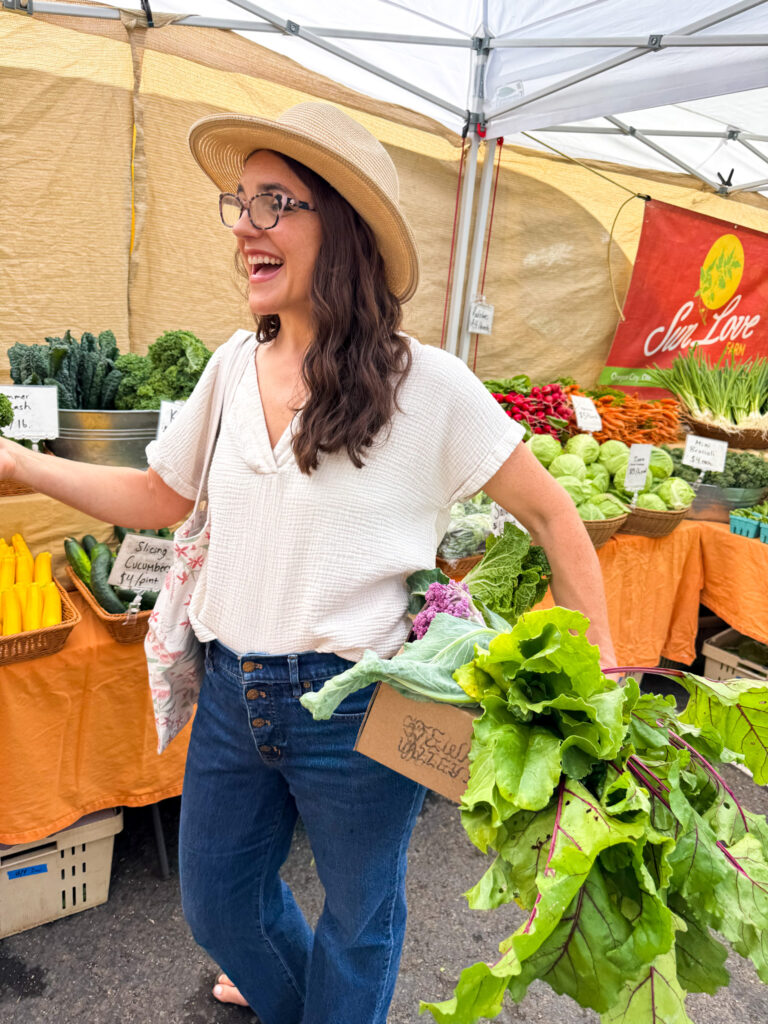Winter meals are about survival — soups that bubble away for hours, and root vegetables that, if you forget them in the crisper too long, go from crisp to Gumby-flexible. (If you grew up in the ’80s like me, you know exactly what I mean. #IYKYK)
But spring? Spring feels like the farmers market is throwing open the windows and shouting, “We’re back!”
Suddenly there are greens so fresh they squeak when you chew, asparagus that insists on being roasted tonight, and herbs that make you want to throw them in your water just because you can.
And honestly, spring shopping is part nutrition, part treasure hunt. My kids know the rule: everyone gets to pick one “mystery item” each week. Sometimes it’s a gorgeous bunch of radishes, sometimes it’s an unidentifiable root that we Google at home while I pray it’s edible. Either way—it’s food as adventure.
What’s in Season This Spring (Pacific Northwest)
Early Spring (March)
- Spinach, kale, Swiss chard, arugula
- Radishes, spring onions, overwintered carrots & beets
- Asparagus (early harvests)
- Fresh farm eggs
- Nettles, chickweed, miner’s lettuce (forage)
Late Spring (April–May)
- Rhubarb
- Strawberries
- Cherries (early June overlap)
- Fresh herbs: dill, cilantro, mint, parsley, chives
- Peas (sugar snap & shelling)
What to Plant This Week (Garden Planning)
Cool-weather crops thrive in early spring. Depending on your frost date:
- Direct Sow Outdoors: peas, radishes, carrots, spinach, arugula, lettuce mixes
- Start Indoors / Greenhouse: tomatoes, peppers, brassicas (broccoli, cauliflower, cabbage)
- Herbs: dill, cilantro, parsley (fast growers)
👉 Homeschool tie-in: kids can chart seed germination rates, measure plant growth, or keep a “garden journal” to track progress.
What to Forage This Month (Wild Food Guide)
- Nettles: best harvested young; mineral-rich, delicious in soup or tea
- Dandelion greens: support digestion + liver health
- Chickweed: tender, mild, perfect for salads
- Miner’s lettuce: vitamin C-rich, grows wild in shady spots
- Morel mushrooms: spring favorite, though always forage mushrooms with an expert
(Safety Note: Always use a guidebook or forage with someone experienced before eating wild plants.)
How to Shop the Farmers Market Like a Pro
- Bring cash & bags—farmers appreciate it, though most now take cards.
- Scout before you buy: walk the full market, compare quality & price.
- Talk to farmers: ask how food was grown, when it was picked, and best storage/cooking methods.
- Try something new: make it a weekly family challenge to try one food you’ve never cooked before.
👉 Homeschool tie-in: give each child $2–5 to choose their own seasonal item, then build a recipe around it together.

Homeschool Harvest Journal
Turn market day into learning:
- Math: calculate price per pound, manage a budget.
- Science: identify plant parts (root, stem, leaf, flower, seed).
- Art/Nature Study: sketch what’s in season in a market or field journal.
- Cooking & Life Skills: simple recipes with market finds (radish butter, nettle pesto, spring pea salad).
- Geography/History: trace origins of foods (e.g., how rhubarb traveled from Asia to Europe).
Seasonal Wellness
Spring foods are not random—they support the exact systems your body needs after winter:
- Bitters (arugula, dandelion): stimulate bile flow, aid detoxification.
- Fiber (peas, asparagus): feed gut bacteria for better digestion and immunity.
- Mineral-rich (nettles, spinach): replenish iron, magnesium, and calcium.
- Herbs (cilantro, parsley): support gentle detox and freshen digestion.
Seasonal Cheat Sheet
This Week in Spring (Early March)
- Plant: peas, lettuce, carrots, radishes
- Harvest: spinach, asparagus, overwintered carrots/beets, farm eggs
- Forage: nettles, dandelion, chickweed, miner’s lettuce
Seasonal eating doesn’t just fill your fridge—it roots you in rhythm. Each trip to the farmers market or step into your garden can reconnect you to health, heritage, and the earth’s cycles. This spring, try weaving one seasonal habit into your week: a foraged nettle tea, a farmers market salad, or a few seeds in your garden. You’ll be surprised how alive it makes you feel.
Here’s to eating with the seasons,
Brenna May, NTP